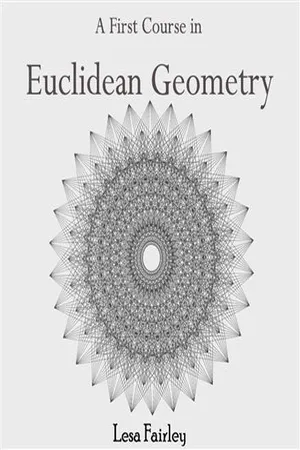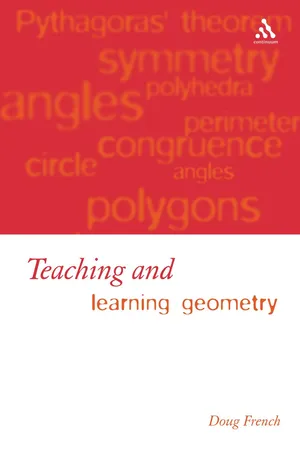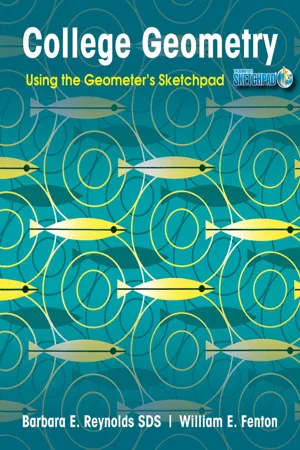Mathematics
Angles in Circles
Angles in circles refer to the measurement of the angles formed by two intersecting lines within a circle. The central angle is an angle with its vertex at the center of the circle, while the inscribed angle is formed by two intersecting chords. These angles have specific relationships and properties, such as the central angle being twice the measure of the inscribed angle.
Written by Perlego with AI-assistance
Related key terms
1 of 5
9 Key excerpts on "Angles in Circles"
- eBook - PDF
Sixth Form Pure Mathematics
Volume 1
- C. Plumpton, W. A. Tomkys(Authors)
- 2014(Publication Date)
- Pergamon(Publisher)
CHAPTER IV THE CIRCULAR FUNCTIONS 4.1 Definition of an Angle An angle is defined here as the amount of anti-clockwise rotation of a radius vector about an axis through one end of the radius, from a fixed initial position. Using degrees as units of angle measurement, Figs. 36 show angles of 210°, 440° (one revolution +80°) and -120° (clock-wise rotation). For convenience of reference, one revolution of the radius vector is divided into four quadrants as illustrated in Fig. 36 (i). -2nd Quodrant / / 3rd Quadront i 1st Quadront ■£ ► * 4 th Quadrant (i) 210° , c /r, cosine d=x/r, tangent d=y/x, cotangent 0= 1/tangent 0, secant 0 = 1/cosine 0, cosecant 6 = 1/sin 6. The names of these functions will be abbreviated as sin, cos, tan, cot, sec and cosec respectively. These definitions include the definitions of the functions for acute and obtuse angles which suffice for the numerical solution of triangles. Formulae and methods based on those definitions will remain valid with the new ones. Following directly from the defi-nitions : |sin0|^=l, | c o s 0 | ^ l , |sec 01=3*1, |cosec0|^l, and there is no limitation on the values of tan 0 and cot 0. Signs of the Circular Functions. It follows from the definitions above that the signs of the circular functions are as illustrated in Fig. 38 (i). - No longer available |Learn more
- (Author)
- 2014(Publication Date)
- Learning Press(Publisher)
Measuring angles Termination of X-axis in anticlockwise direction is called angle. Two angles are some-times called congruent if there exists an isometry that transforms one of the angles into the other angle. The size of an angle is normally characterized by the smallest positive rotation that maps one of the rays into the other. Two angles are congruent if and only if they correspond to the same (smallest positive) rotation. Thus an angle as two rays is characterized by an angle of rotation. To avoid confusion when no isometry exists between particular representations of angles, angles that Euclid called equal are described as equal in measure. In many geometrical situations, angles that differ by an exact multiple of a full circle are effectively equivalent (it makes no difference how many times a line is rotated through a full circle because it always ends up in the same place). However, this is not always the case. For example, when tracing a curve such as a spiral using polar coordinates, an extra full turn gives rise to a quite different point on the curve. The angle θ is the quotient of s and r In order to measure an angle θ , a circular arc centered at the vertex of the angle is drawn, e.g. with a pair of compasses. The length of the arc s is then divided by the radius of the ________________________ WORLD TECHNOLOGIES ________________________ circle r , and possibly multiplied by a scaling constant k (which depends on the units of measurement that are chosen): The value of θ thus defined is independent of the size of the circle: if the length of the radius is changed then the arc length changes in the same proportion, so the ratio s / r is unaltered. Units In dimensional analysis, angles are considered to be dimensionless. There are several units used to measure angles, depending on the choice of the constant k in the formula above. Of these units, treated in more detail below, the degree and the radian are by far the most common. - eBook - PDF
- Michael Hvidsten(Author)
- 2016(Publication Date)
- CRC Press(Publisher)
Definition 2.30. Note that one of the two open arcs defined by a (non-diameter) chord AB will be within the angle ∠ AOB . This will be called a minor arc. This is arc a 1 in Figure 2.28. The arc that is exterior to this angle is called a major arc. This is arc a 2 in the figure. O A c B a1 a2 P Figure 2.28 2.6.2 Inscribed Angles and Figures Definition 2.31. A central angle of a circle is one that has its vertex at the center of the circle. For example, ∠ AOB in Figure 2.28 is a central angle of the circle c . An inscribed angle of a circle within a major arc is one that has its vertex on the circle at a point on the major arc and has its sides intercepting the endpoints of the arc ( ∠ AP B in the figure). Euclidean Geometry � 97 Let’s look at some basic properties of inscribed angles. Theorem 2.31. The measure of an angle inscribed in a circle is half that of its intercepted central angle. Proof: Let ∠ AP B be inscribed in circle c having center O . Let −→ PO intersect circle c at Q . Then, either A and B are on opposite sides of ←→ PO (as shown in Figure 2.29), or A is on the diameter through OP , or A and B are on the same side of ←→ PO . We will prove the result in the first case and leave the remaining cases as an exercise. O A c B P Q Figure 2.29 Now, OP ∼ = OA and Δ POB and Δ POA are isosceles. Thus, = OB ∼ the base angles are congruent (Theorem 2.14). Let α = m ∠ PBO and β = m ∠ P AO . Then, m ∠ POB = 180 − 2 α and m ∠ POA = 180 − 2 β . Also, m ∠ QOB = 2 α and m ∠ QOA = 2 β . Clearly, the measure of the angle at P , which is α + β , is half the measure of the angle at O , which is 2 α + 2 β . � The following two results are immediate consequences of this theo-rem. Corollary 2.32. If two angles are inscribed in a circle such that they share the same arc, then the angles are congruent. 98 � Exploring Geometry Corollary 2.33. An inscribed angle in a semi-circle is always a right angle. - No longer available |Learn more
- Daniel C. Alexander, Geralyn M. Koeberlein, , , Daniel C. Alexander, Geralyn M. Koeberlein(Authors)
- 2014(Publication Date)
- Cengage Learning EMEA(Publisher)
Due to electronic rights, some third party content may be suppressed from the eBook and/or eChapter(s). Editorial review has deemed that any suppressed content does not materially affect the overall learning experience. Cengage Learning reserves the right to remove additional content at any time if subsequent rights restrictions require it. A Look Back at Chapter 6 One goal in this chapter has been to classify angles inside, on, and outside the circle. Formulas for finding the measures of these angles were developed. Line and line segments related to a circle were defined, and some ways of finding the measures of these segments were described. Theorems involving inequalities in a circle were proved. Some constructions that led to tangents of circles were considered. A Look Ahead to Chapter 7 One goal of Chapter 7 is the study of loci (plural of locus), which has to do with point location. In fact, a locus of points is often noth-ing more than the description of some well-known geometric figure. Knowledge of locus leads to the determination of whether certain lines must be concurrent (meet at a common point). Finally, we will extend the notion of concurrence to develop further properties and terminology for regular polygons. - eBook - PDF
- Bernard Kolman, Arnold Shapiro(Authors)
- 2014(Publication Date)
- Academic Press(Publisher)
CHAPTER SIX ANGLES AND TRIANGLES In the previous chapter we discussed trigonometry in terms of functions of real numbers. This approach has the advantage of illustrating the centrality of the function concept in much of modern mathematical thinking. We will now turn to the more traditional approach to trigonometry, which revolves about the measurement of triangles. We will show that it is possible to define the trigonometric functions as functions of angles rather than as functions of real numbers, and that the two definitions are related in a simple manner. Our attention then turns to the right triangle and we will have our first opportunity to explore a wide variety of applications that clearly demonstrate the usefulness of trigonometry in such fields as sur-veying and navigation. We will conclude by examining the law of sines and the law of cosines, two important rules that can be employed when dealing with an oblique triangle, that is, a triangle that does not contain a right angle. 6.1 ANGLES AND THEIR MEASUREMENT In the study of trigonometry we shall view an angle as the result of a ray or half-line that rotates about its endpoint. When the ray coincides with the 244 6.1 ANGLES AND THEIR MEASUREMENT 245 positive jc-axis with its endpoint at the origin, the angle generated is said to be in standard position. In Figure la the x-axis, called the initial side, ky ^Terminal side Initial side J X P Terminal side k y Initial side x (a) (b) FIGURE 1 rotates in a counterclockwise direction until it coincides with the terminal side, forming the angle a. In this case, we say that a is a positive angle. In Figure lb, the ray has been rotated in a clockwise direction to form the angle /?. In this case, we say that fi is a negative angle. If the terminal side coincides with a coordinate axis, then the angle is called a quadrantal angle; otherwise, the angle is said to lie in the same quadrant as its terminal side. There are two commonly used units for measuring angles. - eBook - PDF
- Doug French(Author)
- 2004(Publication Date)
- Continuum(Publisher)
This is particularly effective in the case of the angle at the centre theorem. This states that the angle at the centre of a circle is twice the angle at the circumference subtended by, or standing on, the same arc. Figure 9.13 displays an example from a dynamic geometry screen where the angle at the centre is clearly twice the angle at the circumference. Varying the point P or the other points or the radius of the circle will create a host of other confirming examples, although there will be some occasions when the rounding of the measures should cause questions to be asked about whether the result is approximately or exactly true. There is a clear need for proof-measuring is not sufficient. The usual proof, illustrated in Figure 9.14, is based on isosceles triangles. In the left-hand diagram, with the line PO produced to some point C, the two angles AOC and BOC are external The Circle 111 Figure 9.13 Angles at the centre and circumference Figure 9.14 Proving the angle at the centre theorem angles of the isosceles triangles AOP and BOP. - eBook - PDF
Geometry
A Self-Teaching Guide
- Steve Slavin, Ginny Crisonino(Authors)
- 2004(Publication Date)
- Wiley(Publisher)
C = πd Divide both sides of the equation by π. = d Now we have an equation for the diameter of a circle. = d We’ll substitute the values for C and π. d ≈ 5.1 inches The symbol we’ll use for a circle is . A chord is a line joining any two points on the circumference. Thus AB and AC are chords of the following circle. C A B O 16 3.14 C π 76 GEOMETRY An arc is part of the circumference of a circle. The symbol for arc is . Thus AB refers to arc AB. An arc of 1° is th of a circle. It’s important to distinguish between chords and arcs named with the same letters. In the previous circle, chord AB is a straight line joining points A and B, which are both on the circumference of the circle. But arc AB is actually the curved part of the circumference running from point A to point B. A diameter is a chord that runs through the center of the circle; it’s the longest possi- ble chord. Thus in the last figure, AC is the diameter of O. The diameter divides a circle into two semicircles. A semicircle is an arc equal to one-half of the circumference of a circle; a semicircle contains 180°. Example 6: Draw a chord, CD, on M. Solution: Here are two of the many possible chords. Are you ready for some congruent circles? Congruent circles are circles having con- gruent radii. Thus if OE = O′G′, then circle O circle O′. O G' F E O' M C D M C D M 1 360 Circles 77 Here’s one last term: central angle. A central angle is an angle formed by two radii. In the following figure, the angle between radii OB and OC is a central angle. Therefore, the central angle between OB and OC is O, which can also be writ- ten BOC. Sometimes angles are not represented in degrees, but in units called radians. If a central angle of a circle intercepts an arc equal in length to the radius of the cir- cle, the central angle is defined as 1 radian. Because the radius can be marked off along the circumference 2π (or about 6.28) times, we see that 2π = 360°, or π = 180°. - eBook - PDF
College Geometry
Using the Geometer's Sketchpad
- Barbara E. Reynolds, William E. Fenton(Authors)
- 2012(Publication Date)
- Wiley(Publisher)
DISCUSSION 89 A chord of a circle is a line segment joining two points on the circle. A chord that passes through the center of the circle is called a diameter. Using Sketchpad, we can construct a diameter of a circle by constructing a line through the center of the circle, and then finding the line segment between the points where this line intersects the circle. While a chord intersects a circle at two points, a tangent is a line that intersects a circle at exactly one point. The point where a tangent line touches the circle is called the point of tangency. It is not difficult to prove that a tangent line is perpendicular to a radius at the point of tangency. The circumference of a circle is the length of its perimeter. An arc of a circle is a piece of the circle. A sector of a circle is a pie-shaped portion of the inte- rior of the circle, bounded by an arc of the circle and two radii. If P, Q, and R are three points on a circle with center at O, the angle POR is called a central angle of the circle, and the angle PQR is an inscribed angle. The angle PQR may also be called an angle subtended by the chord PR. We can define the mea- sure of an arc as the measure of the central angle subtended by the arc. This allows us to reword the statement about inscribed angles: The measure of an inscribed angle is half the measure of the arc subtending the inscribed angle. It turns out to be convenient at times to be able to refer to the arc rather than the central angle. Since a tangent to a circle, C , is a line perpendicular to a radius of C at the point of tangency, it is easy to construct a tangent to the circle C at a point A which is on C . To construct a tangent to C from a point B that is exte- rior to the circle, use the idea that an angle inscribed in a semicircle is a right angle. Construct a line segment from the point B to the center of C , then con- struct its midpoint, M. A circle centered at M with radius MB will intersect C in two points, P 1 and P 2 . - eBook - PDF
Pre-Calculus All-in-One For Dummies
Book + Chapter Quizzes Online
- Mary Jane Sterling(Author)
- 2023(Publication Date)
- For Dummies(Publisher)
3 The Essentials of Trigonometry IN THIS UNIT . . . Reviewing angles and angle types, along with their properties. Determining trig function values using degrees and radians. Graphing basic trig functions. Transforming trig function graphs. CHAPTER 8 Circling In on Angles 173 Circling In on Angles I n this chapter, you find right triangles drawn on the coordinate plane (x- and y-axes). Moving right triangles onto the coordinate plane introduces many more interesting concepts such as evaluating trig functions and solving trig equations. Also, you become acquainted with a very handy tool known as the unit circle. The unit circle is extremely important in the real world and in mathematics; for instance, you’re at its mercy whenever you fly in an airplane. Pilots use the unit circle, along with vec- tors, to fly airplanes in the correct direction and over the correct distance. Imagine the disaster that would result if a pilot tried to land a plane a bit to the left of the runway! In this chapter, you work on building the unit circle as you review the basics of angles in radians and degrees as they’re found in triangles. With that information, you can place the triangles onto the unit circle (which is also located in the coordinate plane) to solve the prob- lems at the end of this chapter. (You find more on these ideas as you move into graphing trig functions in Chapter 10.) Introducing Radians and Relating to Degrees When you first studied geometry, you probably measured every angle in degrees, based on a portion of a 360 circle around a point. As it turns out, the number 360 was picked to represent the degrees in a circle only for convenience. Chapter 8 IN THIS CHAPTER » Discovering alternate trig function definitions » Inserting triangles on the unit circle » Calculating trig functions on the unit circle
Index pages curate the most relevant extracts from our library of academic textbooks. They’ve been created using an in-house natural language model (NLM), each adding context and meaning to key research topics.








